身体语言的秘密sofBodyLanguage图文稿
- 格式:docx
- 大小:52.18 KB
- 文档页数:70


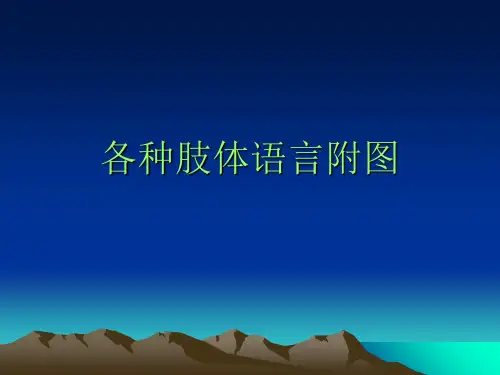
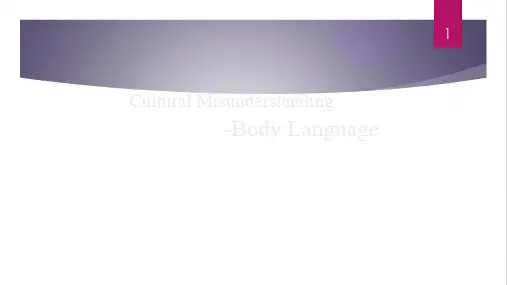
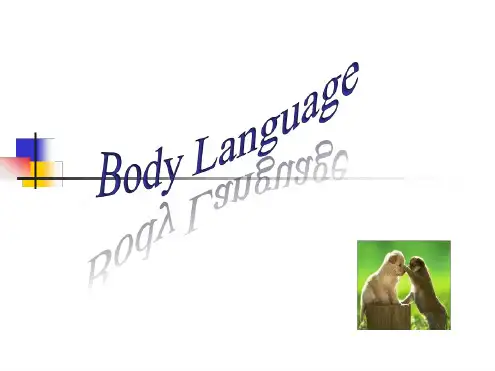


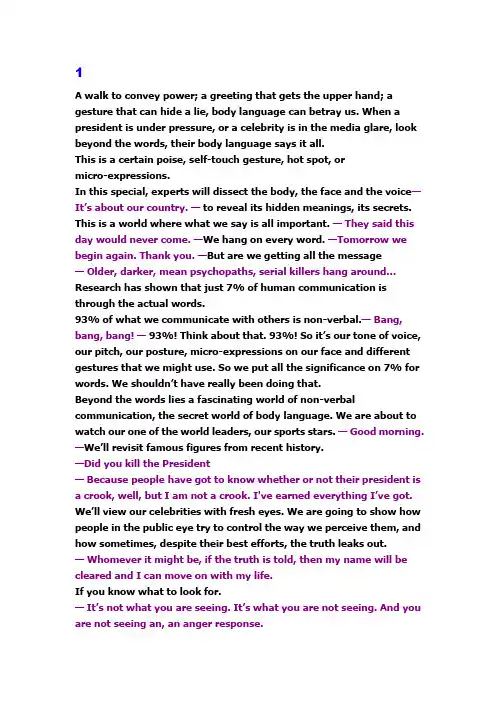
1A walk to convey power; a greeting that gets the upper hand; a gesture that can hide a lie, body language can betray us. When a president is under pressure, or a celebrity is in the media glare, look beyond the words, their body language says it all.This is a certain poise, self-touch gesture, hot spot, ormicro-expressions.In this special, experts will dissect the body, the face and the voice—It’s about our country. —to reveal its hidden meanings, its secrets. This is a world where what we say is all important. — They said this day would never come. —We hang on every word.—Tomorrow we begin again. Thank you. —But are we getting all the message —Older, darker, mean psychopaths, serial killers hang around…Research has shown that just 7% of human communication is through the actual words.93% of what we communicate with others is non-verbal.— Bang, bang, bang! —93%! Think about that. 93%! So it’s our tone of voice, our pitch, our posture, micro-expressions on our face and different gestures that we might use. So we put all the significance on 7% for words. We shouldn’t have really been doing that.Beyond the words lies a fascinating world of non-verbal communication, the secret world of body language. We are about to watch our one of the world leaders, our sports stars.— Good morning. —We’ll revisit famous figures from recent history.—Did you kill the President— Because people have got to know whether or not their president is a crook, well, but I am not a crook. I've earned everything I’ve got. We’ll view our celebrities with fresh eyes. We are going to show how people in the public eye try to control the way we perceive them, and how sometimes, despite their best efforts, the truth leaks out.— Whomever it might be, if the truth is told, then my name will be cleared and I can move on with my life.If you know what to look for.—It’s not what you are seeing. It’s what you are not seeing. And you are not seeing an, an anger response.We are going to equip you with the tools to read those body language giveaway.2You’re getting a hidden peek, a peek into the world of what’s really going on there. When you can read body language, every moment you spend with others, you can make it valuable, and if you are in business, you can make it profitable. Body language is crucial.For those who study nonverbal communication, one of the first indicators they look out for is the way someone’s body moves.At this Camp David Summit, President Bush is the host to visiting Russian President Vladimir Putin.Vladimir Putin knows the world is watching him on American soil and he also knows that his people are watching, so he must show strength.Here though, both leaders are making a strong body language statement. Now here we are, two powerful world leaders in a sort of striding contest, because of course, the faster you stride, the more strong, powerful and fit you are.But it’s not just the speed of walking that sends out messages.Vladimir Putin and George Bush, both of whom are fantastically powerful men, have two completely different kinds of power and it, evidences itself through body language.I thank you all for coming.Vladimir Putin has, what I would call, a very animal power, a strong man power. And he walks by having his shoulders that are actually bouncing back and, back and forth. And he walks. He also makes gestures. He is very active. I would almost call it a kind of sexy power. George Bush, on the other hand, has a more traditional, and I would say, American power. There is a very little movement above the shoulders. He’s trying to look like he’s controlled. There is no extra wasted energy.I thank you all for coming.Perceiving the body language message of these two powerful Presidents is straightforward. But body language is often complex and easily misunderstood. Here President Clinton leads Israeli and Palestinian leaders Ehud Barak and Yasser Arafat out before the press during peace negotiations. It’s all smiles for the cameras. But behind the facade of bonhomie, there is a power struggle going on. Clinton jokingly explains that none of them will take any questions. We pledged to each other that we would answer no questions and offer no comments. So, I have to set a good example.The body language then revealed just why that was.3Oh, my!Well…Wow, almost a physical fight.Many view this apparently light-hearted tussle as a sign that Arafat and Barak were getting on well. Think again.There is a, a great meaning behind who goes through the door first. Now, of course, see that here in the West, letting someone through the door first that doesn’t really matter, polite maybe. But in the Middle East, it has significan t cultural impact.The host, the power person says I’m in control, I’ll help you through the door, I’ll show you the way.Thank you.Throwing the fear and tension presented in most Middle East negotiations, and suddenly the desire of both Arafat and Barak not to go through that door before the other starts to make sense.This is a classic example in an extreme way of how the last man through the door is the winner. So Barak reaches for Yasser Arafat. Arafat literally grabs this on, moves around and starts waggling his finger at Barak who then, Barak then uses it as an opportunity like a wrestling match to move around, to actually be behind Arafat and then literally grabs Arafat, to hold him by the arm and shoves him through the door boldly.So you’ve got fea r and power struggle showing in big, big, big, big, bold body language movements.Arafat and Barak are not the only ones to appreciate the significance of the last man through the door move. Even when friends and allies meet, subtle cues reveal who’s top d og.2003, British Prime Minister Tony Blair plays host to President Bush.In this particular example, we are looking at No.10 Downing Street and one would expect Tony Blair to be very territorial. It’s his territory. He should be host. He should be in charge and the boss in terms of who at least goes through the door.And yet, Tony Blair the Prime Minister accepts that the seniority in place here is the President. So President Bush says photo job is over, gives him a little nod, and so they start getting in. The…4The president is in charge of the choreography.He goes through the door last. He uses his left hand and taps Blair forward, not shoving Blair through the door, but helping him through the door, meaning Bush is in charge.As they go in, the president being in charge and wanting him to be clear that he is in charge, not only displays the ownership symbol of putting his hand on Tony Blair's back, but then he displays a further bit of dominance—gives him three little taps, just to let him know that actually he is a good little boy and that George W. Bush is boss.A pat on the back is one way to demonstrate power. Getting the upper hand is another, quite literally.When body language savvy world leaders get together, they know there's one sure fire moment to demonstrate dominance, the handshake photo while.If you're looking at the left of the picture, they always wanna be standing on the left of the picture. Let me demonstrate. If I'm shaking hands here, what's gonna happen I'm at the bottom of the handshake. My palm is facing up. That's a very vulnerable position. If I'm shaking hands here, and I've got my arm around the person I'm shaking hands, who is in, who’s got the upper hand I've got the upper hand.If someone's coming in to shake your hand like this, here's the nice solid handshake. It should be straight and firm. If it's not...Janine Driver teaches body language evening classes.It’s kind of hard to dominate. You are a powerful boy...She believes the visual impact of important handshakes was first appreciated in 1970 when Elvis Presley famously paid a visit to President Nixon at the White House.We see a picture of Nixon and he’s shaking hands with Elvis Presley. Nixon's got the upper hand. That's where the expression comes from—I've got the upper hand here. So now that people know about this in politics, you see them jogging for position when it comes time to take the picture.At this Summit in 2006 hosted by Vladimir Putin, the Russian leader was on full handshake alert.He’s strategically placed himself in a position where when they're coming forward, he's gonna get the dominant position. They are coming out of cars, this way they're coming up to him. The cameras are here. Every single picture, who gets the upper hand Putin.Then up strides Tony Blair.We see that Tony Blair is going to actually grab onto Vladimir Putin's hands that, this classic thing of grabbing somebody by the elbow to show who is actually the leader.Score one for Blair.PS:开篇的“The”为续片段3片末的最后一个单词。


目录•Introduction to Body Language •Basic Elements of Body Language •Interpreting Body Language Signals •Cultural Variations in Body Language•Applications of Body Language KnowledgeDefinition and Importance of Body Language DefinitionBody language refers to the non-verbal communications that we use to express our feelings, thoughts, and attributes through physical behaviors such as legal expressions, eye contacts, styles, posts, and spatial relationshipsImportanceBody language plays a critical role in communication as it can convey messages that words alone cannot be It can be completed, reinforced, or even direct verbal communication, and is essential for building trust and rapport in relationshipsFunctions of Body Language in CommunicationCross Cultural Differences in Body LanguageFacial Expressions and Eye ContactFacial ExpressionsEye ContactEyebrow MovementGestures and PosturesGesturesPosturesHead MovementsVocal Elements such as Tone, Pitch, and VolumeTone01Pitch02Volume03Proxemics This refers to the use of space and distance in communication People from different cultures may have different comfort levels with personal space Standing too close to someone can make them feel uncomfortable, while standing too far away can make communication difficult要点一要点二Personal SpaceThe amount of personal space people require canvary depending on cultural norms and personal preferences In some cultures, it is acceptable to stand close to others during conversation, while in others maintaining a greater distance is preferredProxemics and Personal SpaceUnderstanding Non verbal Cues in Different ContextsNon verbal cues can indicate power dynamics between individuals, such as eye contact, pose, and spatial distancePower DynamicsBody language varies across cultures, so it's important to understand thenorms and expectations of non-verbal communication in different cultural contextsCultural Differences Body language can change depending on the social settings, so as in a business meeting, a casual conversation, or a romantic dateSocial SettingsMixed MessagesPeople may say one thing verbally but communicate something different non-verbally, so as sliming while saying something negativeIncongruence betweenverbal and non-verbalmessages can be a sign ofperception, as people mayhave diverse control overboth sidesSometimes, people's wordsand body language may notmatch due to emotionaldisconnect or internalconflictConceptDetectionEmotionalDisconnectRecognizing Incongruence between Verbal and Non Verbal Messages01 02 03Clusters of Cues MicroexpressionsBody Language and PersonalityAnalyzing Complex Body Language PatternsFarewell rituals also have buffer across cultures In some cultures, it is customary to say Goodbyeand then walk away, while in others, so as in the Middle East, it is common to say Goodbye and then stand and watch the other person leaveIn some cultures, such as in the United States, it is common to shake hands when meetingsomeone, while in other cultures, such as in Japan, a slim nod or bow is the preferred meetingThe use of Kisses on the Cheek or Hugs as greetings varies widely across cultures In some LatinAmerican countries, for example, it is common to meet someone with a kiss on the Cheek, while in many Asian cultures, this type of physical contact is many less commonGreeting and Farewell Rituals across CulturesGestures that Have Different Meanings in Different CulturesNorms for Eye Contact and Personal Space Vary by CultureImproving Interpersonal Communication SkillsUnderstanding non-verbal cuesBuilding trust and rapportManaging conflictEnhancing Public Speaking AbilitiesCommanding the stageConveying emotionManaging emotionsDeveloping Leadership Quality through Non verbal Communication。
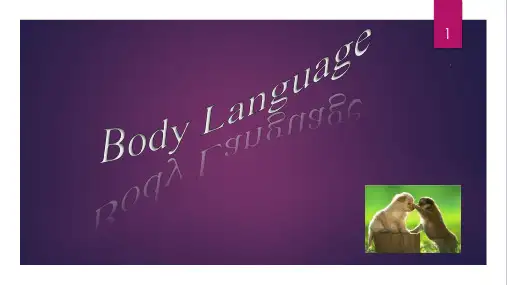
身体语言的秘密s o f B o d y L a n g u a g e 文件管理序列号:[K8UY-K9IO69-O6M243-OL889-F88688]1A walk to convey power; a greeting that gets the upper hand; a gesture that can hide a lie, body language can betray us. When a president is under pressure, or a celebrity is in the media glare, look beyond the words, their body language says it all. This is a certain poise, self-touch gesture, hot spot, ormicro-expressions.In this special, experts will dissect the body, the face and the voice—It’s about our country. —to reveal its hidden meanings, its secrets.This is a world where what we say is all important. — They said this day would never come. —We hang on every word.—Tomorrow we begin again. Thank you. —But are we getting all the message— Older, darker, mean psychopaths, serial killers hang around…Research has shown that just 7% of human communication is through the actual words.93% of what we communicate with others is non-verbal.— Bang, bang, bang! —93%! Think about that. 93%! So it’s our tone of voice, our pitch, our posture, micro-expressions on our face and different gestures that we might use. So we put all thesignificance on 7% for words. We shouldn’t have really been doing that.Beyond the words lies a fascinating world of non-verbal communication, the secret world of body language. We are aboutto watch our one of the world leaders, our sports stars.—Good morning. —We’ll revisit famous figures from recent history.—Did you kill the President— Because people have got to know whether or not theirpresident is a crook, well, but I am not a crook. I've earned everything I’ve got.We’ll view our celebrities with fresh eyes. We are going to show how people in the public eye try to control the way we perceive them, and how sometimes, despite their best efforts,the truth leaks out.— Whomever it might be, if the truth is told, then my namewill be cleared and I can move on with my life.If you know what to look for.—It’s not what you are seeing. It’s what you are not seeing. And you are not seeing an, an anger response.We are going to equip you with the tools to read those body language giveaway.2You’re getting a hidden peek, a peek into the world of what’s really going on there. When you can read body language, every moment you spend with others, you can make it valuable, and if you are in business, you can make it profitable. Body languageis crucial.For those who study nonverbal communication, one of the first indicators they look out for is the way someone’s body moves.At this Camp David Summit, President Bush is the host tovisiting Russian President Vladimir Putin.Vladimir Putin knows the world is watching him on American soil and he also knows that his people are watching, so he must show strength.Here though, both leaders are making a strong body language statement.Now here we are, two powerful world leaders in a sort ofstriding contest, because of course, the faster you stride, the more strong, powerful and fit you are.But it’s not just the speed of walking that sends out messages. Vladimir Putin and George Bush, both of whom are fantastically powerful men, have two completely different kinds of power and it, evidences itself through body language.I thank you all for coming.Vladimir Putin has, what I would call, a very animal power, a strong man power. And he walks by having his shoulders that are actually bouncing back and, back and forth. And he walks. He also makes gestures. He is very active. I would almost call it a kind of sexy power. George Bush, on the other hand, has a more traditional, and I would say, American power. There is a very little movement above the shoulders. He’s trying to look like he’s controlled. There is no extra wasted energy.I thank you all for coming.Perceiving the body language message of these two powerful Presidents is straightforward. But body language is often complex and easily misunderstood.Here President Clinton leads Israeli and Palestinian leaders Ehud Barak and Yasser Arafat out before the press during peace negotiations. It’s all smiles for the cameras. But behind the facade of bonhomie, there is a power struggle going on. Clinton jokingly explains that none of them will take any questions. We pledged to each other that we would answer no questions and offer no comments. So, I have to set a good example.The body language then revealed just why that was.3Oh, my!Well…Wow, almost a physical fight.Many view this apparently light-hearted tussle as a sign that Arafat and Barak were getting on well. Think again.There is a, a great meaning behind who goes through the door first. Now, of course, see that here in the West, letting someone through the door first that doesn’t really matter, polite maybe. But in the Middle East, it has significant cultural impact.The host, the power person says I’m in control, I’ll help you throug h the door, I’ll show you the way.Thank you.Throwing the fear and tension presented in most Middle East negotiations, and suddenly the desire of both Arafat and Barak not to go through that door before the other starts to make sense.This is a classic example in an extreme way of how the last man through the door is the winner. So Barak reaches for Yasser Arafat. Arafat literally grabs this on, moves around and starts waggling his finger at Barak who then, Barak then uses it as anopportunity like a wrestling match to move around, to actuallybe behind Arafat and then literally grabs Arafat, to hold himby the arm and shoves him through the door boldly.So you’ve got fear and power struggle showing in big, big, big, big, bold body language movements.Arafat and Barak are not the only ones to appreciate the significance of the last man through the door move. Even when friends and allies meet, subtle cues reveal who’s top dog. 2003, British Prime Minister Tony Blair plays host to President Bush.In this particular example, we are looking at No.10 Downing Street and one would expect Tony Blair to be very territorial. It’s his territory. He should be host. He should be in charge and the boss in terms of who at least goes through the door.And yet, Tony Blair the Prime Minister accepts that theseniority in place here is the President. So President Bushsays photo job is over, gives him a little nod, and so theystart getting in. The…4The president is in charge of the choreography.He goes through the door last. He uses his left hand and taps Blair forward, not shoving Blair through the door, but helping him through the door, meaning Bush is in charge.As they go in, the president being in charge and wanting him to be clear that he is in charge, not only displays the ownership symbol of putting his hand on Tony Blair's back, but then he displays a further bit of dominance—gives him three little taps, just to let him know that actually he is a good little boy and that George W. Bush is boss.A pat on the back is one way to demonstrate power. Getting the upper hand is another, quite literally.When body language savvy world leaders get together, they know there's one sure fire moment to demonstrate dominance, the handshake photo while.If you're looking at the left of the picture, they always wanna be standing on the left of the picture. Let me demonstrate. If I'm shaking hands here, what's gonna happen I'm at the bottom of the handshake. My palm is facing up. That's a very vulnerable position. If I'm shaking hands here, and I've got my arm around the person I'm shaking hands, who is in, who’s got the upper hand I've got the upper hand.If someone's coming in to shake your hand like this, here's the nice solid handshake. It should be straight and firm. If it's not...Janine Driver teaches body language evening classes.It’s kind of hard to dominate. You are a powerful boy...She believes the visual impact of important handshakes wasfirst appreciated in 1970 when Elvis Presley famously paid a visit to President Nixon at the White House.We see a picture of Nixon and he’s shaking hands with Elvis Presley. Nixon's got the upper hand. That's where the expression comes from—I've got the upper hand here. So nowthat people know about this in politics, you see them jogging for position when it comes time to take the picture.At this Summit in 2006 hosted by Vladimir Putin, the Russian leader was on full handshake alert.He’s strategically placed himself in a position where when they're coming forward, he's gonna get the dominant position. They are coming out of cars, this way they're coming up to him. The cameras are here. Every single picture, who gets the upper hand Putin.Then up strides Tony Blair.We see that Tony Blair is going to actually grab onto Vladimir Putin's hands that, this classic thing of grabbing somebody by the elbow to show who is actually the leader.Score one for Blair.PS:开篇的“The”为续片段3片末的最后一个单词。